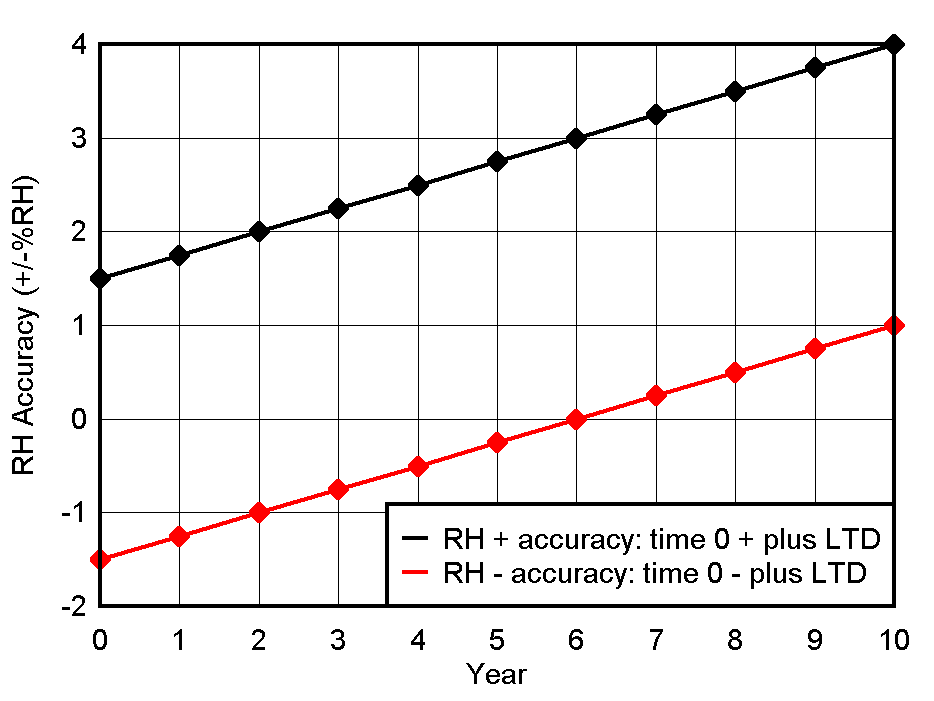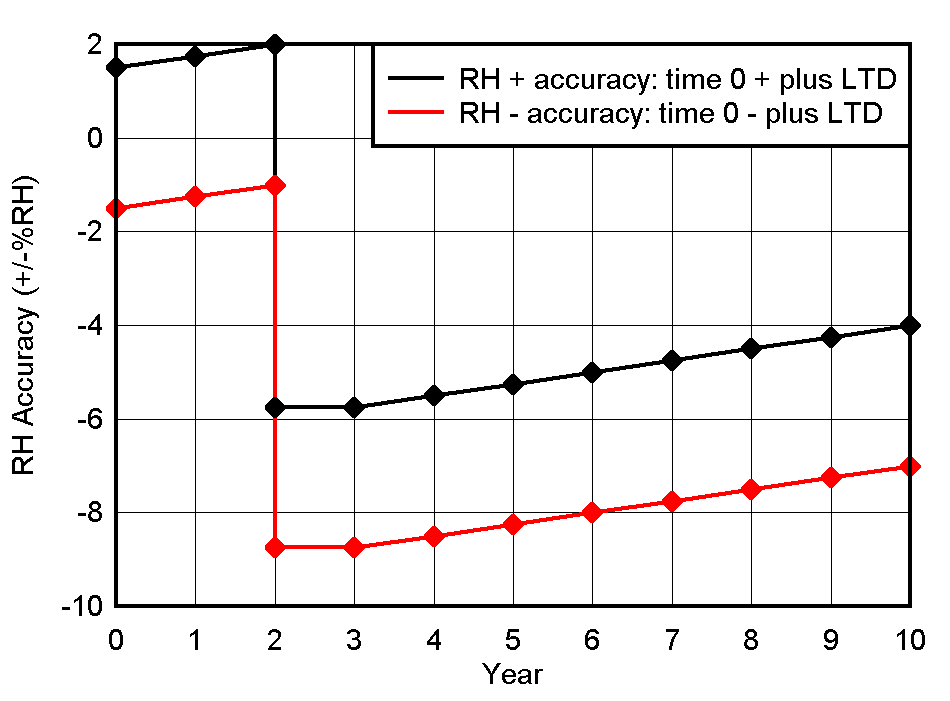SNAA353A June 2021 – August 2021 HDC3020 , HDC3020-Q1 , HDC3021 , HDC3021-Q1 , HDC3022 , HDC3022-Q1
1 Application Brief
Many applications require an accurate relative humidity sensor but the data sheet accuracy specification parameter only tells the specification the day the humidity sensor gets shipped out from the semiconductor manufacturer. Over time that accuracy can shift or drift as a result of a combination of different factors such as natural aging, stress, contaminants, or environmental interactions. This degradation in accuracy over time is especially important to longer lifetime industrial and automotive products such as appliance, automotive, and medical.
Three Causes of Relative Humidity Accuracy Error
Relative humidity (RH) sensor accuracy has three main components: time zero accuracy, hysteresis, and long term drift. They must all be taken into account to determine the sensor’s total RH accuracy. Other components such the sensor’s power supply rejection ratio can be mitigated by using a regulated supply or the sensor having an integrated regulator, such as in HDC3020 family, so those will not be discussed in this paper.
Time zero RH accuracy is the accuracy after calibration during product test before the semiconductor manufacturer ships out the humidity sensor device.
Hysteresis is the memory effect aspect of humidity sensors where the accuracy has an offset dependent on the previous RH and that offset varies based on what the prior RH was. High performance capacitive based RH sensors may reach as low as ±1% RH typical hysteresis error.
After the sensor leaves the factory, shifts or drifts in accuracy can occur. Shifts in the sensor accuracy are temporary as they do not permanently change the sensor material properties. Shifts in RH accuracy can occur from a short exposure to conditions outside the sensor's recommended operating conditions (such as high humidity at room temp) and or short exposure to harsh contaminants (such as dust, gas phase solvents, vapors from packaging materials, adhesives and so on). These shifts are temporary and can be mitigated by letting the device recover on its own or by providing a small amount of heat (for example, a heater) for few seconds.
Over time the exposed sensing element accuracy will drift due to aging and prolonged exposure to extreme conditions (such as high humidity and high temperature) and or harsh contaminants (such as dust, gas phase solvents, vapors from packaging materials and adhesives and so on). Unlike a shift, the drift in accuracy is permanent. Heating the humidity sensor to a high temperature for a long period of time (to bake it) can remove the drift from prolonged exposure to extreme conditions and or harsh contaminants (see HDC3020 Family data sheets (SNAS778 and SNAS817) for more details about baking and re-hydrating the HDC3020 humidity sensor) but is not practical once the sensor is in the field.
Typically the data sheets specify the effect of aging and prolonged exposure to extreme conditions as a long term drift stated in terms of %RH variation in accuracy per year. However, this long term drift is exclusive of shift due to contaminants as the magnitude of shift depends on the specific contaminant, its concentration and length of exposure. Some contaminants add a positive shift in accuracy while others add a negative shift with a magnitude as high as 10% possible in some cases. The more reliable RH sensors achieve a typical long term drift (without consideration of contaminants so just from aging and extreme conditions) of 0.25%RH per year.
When the humidity sensor's RH accuracy shifts or drifts out of specification, the sensor would have to be taken out of service for sensor replacement or calibration, which increases the total cost of ownership. Figure 1-1 shows the additive RH accuracy error of time 0 accuracy and long term drift. Even without contaminants, long term drift alone can double the accuracy error in just six years. A contaminant event, illustrated in Figure 1-2 at year two, can add much more RH error than a device would generally accumulate over a 10 year lifetime.
 Figure 1-1 RH Accuracy at Time Zero Plus
the Long Term Drift Over Time
Figure 1-1 RH Accuracy at Time Zero Plus
the Long Term Drift Over Time Figure 1-2 RH Accuracy at Time Zero Plus
the Long Term Drift Over Time Plus Error From Contaminants
Figure 1-2 RH Accuracy at Time Zero Plus
the Long Term Drift Over Time Plus Error From ContaminantsThe remainder of this article discusses the three vectors for reducing RH error in HDC3020 family: sensing element optimization, protective cover offerings, and drift correction.
RH Error Reduction Vector #1: Sensing Element Optimization
The initial source of RH error is the sensor itself, thus that is the first RH error reduction vector. For capacitive based relative humidity sensors different polymers exhibits various amount of drifts over time. Texas Instruments selected and rigorously tested a new polymer based on the chemical composition and interaction with the environment to ensure low drift for the HDC3020 family. The HDCC3020 family also has a new sensing element with a new capacitor design for improved sensor performance. The new sensing element plus the new polymer for HDC3020 family result in a typical accuracy of ±1.5%RH and a maximum accuracy of ±2%RH with the industry's lowest RH long term drift at 0.21%RH per year. This enables applications which require longer lifetimes such as appliances, automotive, and medical equipment to maintain a higher RH accuracy over their lifetime.
The semiconductor manufacturer chooses the sensor element design and the polymer so the customer only needs to determine the required accuracy performance and conditions applicable to their end product to select the RH humidity sensor that meets their needs. However customers may choose to model accelerated-life, the system is stressed to accelerate failure mechanisms that may occur during the product lifetime, during their RH sensor testing. This can be used to predict the longevity of a RH sensor in harsh environments with respect to functionality but could cause false alarms if used to predict performance. If data sheet specifications are exceeded during testing (for example, recommended temperature limits are exceeded at high temperatures), the sensor's performance can be greatly impacted as a result of the over stress condition. This is especially true for the popular 85˚C/85%RH stress test as capacitive humidity sensors are not specified to operated up to 85˚C. Refer to 85°C/85% accelerated life test impact on polymer-based relative humidity sensors (SLYY210) for additional details related to the impact of the 85˚C/85% RH tests.
RH Error Reduction Vector #2: Protective Cover Offerings
The humidity sensor is in an open cavity package to expose the polymer to the air for detecting water vapor levels so care must be taken when storing and handling the sensor. The HDC3x Silicon User's Guide (SNAU265) provides more details regarding the unique storage and handling guidelines for the open cavity humidity sensor. An alternative or additional option to following special storage and handling guidelines is to purchase a humidity sensor with a protective cover over the cavity opening of the package. The HDC3020 family carries over the protective cover package variant options the previous HDC2080 family offers with HDC3021 and HDC3022 RH sensors. Additional information about these two cover options are in Is a Protective Cover Needed for Humidity Sensors? (SNAA346) application note with a brief summary to follow.
The HDC3021 sensor has removable protective tape (Polyimide) that can prevent chemical contamination during assembly and must be removed before device operation. It can allow for conformal coating and PCB wash during the manufacturing process.
The HDC3022 sensor has a permanent ingress protection 67 (IP67) filter cover (IP67 Rated PTFE Filter) that allows exposure to dust, debris, condensation, as well as, water submergence without reducing the RH response time as some product protective housings might. The cover is designed to adhere to the package over lifetime operation. The cover has a filtration efficiency of 99.99% down to a particle size of 100nm and provides the following protection benefits:
- Dust or particles contamination can be avoided until the point PTFE is completely covered with dust or particles blocking water vapor flow to the sensor cavity.
- Condensation to certain extent will be avoided.
- Water droplets based saturation can be avoided.
RH Error Reduction Vector #3: Drift Correction
Drift from aging cannot be avoided and sometimes exposure to contaminants and or harsh environments cannot be avoided either. The HDC3020 family of RH sensors offers a novel drift correction feature to correct for RH sensor offset, assumed to be constant across the full RH operating range, to return the device to factory accuracy specification. This works well for contaminants that mainly cause an offset error such as ethylene glycol, MEK, IPA, butyl acetate.
Applications that can use this novel drift correction feature will reduce the RH accuracy shift over time and may extend product lifetime and or drop expensive out of service recalibration or device replacement. Drift correction is available on the HDC3x EVM with more details in the HDC3x EVM user's Guide (SNAU267). Documentation for how to use this drift correction feature on individual devices without the EVM will be added to the HDC3x Silicon User's Guide (SNAU265) before the device releases to production.
Conclusion
Texas Instruments has taken a three-prong approach to maintain better RH accuracy over the lifetime of the sensor for the HDC3020 family of humidity and temperature sensors: sensing element optimization, protective cover offerings, and drift correction. Sensing element optimization addresses the sensor error. The protective cover offerings help to reduce contaminant exposure, and drift correction is there to correct for drift from extreme conditions and any other drift sources. The combination of all three results in a humidity sensor with industry’s highest accuracy and lowest drift in extreme conditions. Check out the HDC3020 and HDC3020-Q1 family of devices today to find the right device to extend the RH accuracy of your product over time and in harsh environments.